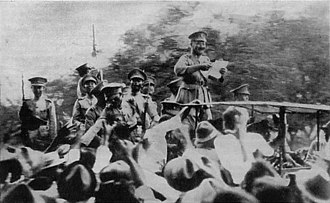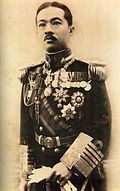Siamese revolution of 1932
The Siamese revolution of 1932 (Thai: การปฏิวัติสยาม พ.ศ. 2475), also known as the Siamese coup d'état of 1932 (Thai: การเปลี่ยนแปลงการปกครองสยาม พ.ศ. 2475), was a takeover by the People's Party (Khana Ratsadon) in Siam on 24 June 1932. It ended the centuries-long absolute monarchy under the Chakri dynasty. The revolution was bloodless and led to Siam becoming a constitutional monarchy, introducing democracy, the first constitution, and creating the National Assembly.
The revolution was driven by dissatisfaction due to the economic crisis, poor government performance, and the rise of Western-educated commoners.
King Prajadhipok stayed on the throne and reached a compromise with the People's Party. However, there were two more coups in the following year, in April and June, due to disagreements within the government over Pridi Banomyong's socialist economic plan and a royalist rebellion.
Siamese Revolution Of 1932 Media
Pridi Banomyong, leader of the civilian faction
Major Plaek Phibunsongkhram, leader of the young army faction
(L to R): Colonel Phraya Songsuradej, Lieutenant Colonel Phra Phrasasphithayayut, Colonel Phraya Phahonphonphayuhasena and Colonel Phraya Ritthiakhaney, the revolutionary four musketeers.
King Prajadhipok wearing khrui and chang kben, armed with krabi
HRH Prince of Nakorn Sawan, the minister of interior and most powerful member in the government
Tanks outside Ananta Samakhom Throne Hall.
Siam Ratsadon Newspaper, the headline reads: "A change of government for Siamese King to be under law"
The granting of Siam's 'permanent' constitution on 10 December 1932 at the Ananta Samakhom Throne Hall










